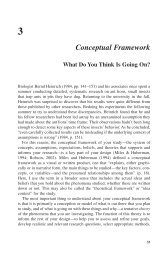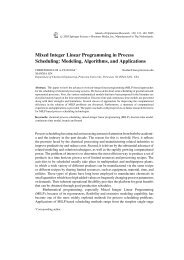Qualitative Research Basics: A Guide for Engineering Educators
Qualitative Research Basics: A Guide for Engineering Educators
Qualitative Research Basics: A Guide for Engineering Educators
Create successful ePaper yourself
Turn your PDF publications into a flip-book with our unique Google optimized e-Paper software.
Epistemological Perspectives<br />
The epistemological perspective of a study is related to the assumed nature of truth and<br />
the approach used to understand and explain reality. Why is the epistemological<br />
perspective of a study important? Because it helps to shape the research design and<br />
makes explicit to others the phenomenon being investigated. Perhaps you are interested<br />
in determining whether students with a higher SAT score do better in engineering. Or you<br />
want to understand how the interactions between students in a problem-solving group do<br />
or do not contribute to better problem solutions. Or you want to show how particular<br />
faculty hiring practices tend to marginalize under-represented minorities. Each of these<br />
studies is in<strong>for</strong>med by a different view of reality, or epistemological perspective, which<br />
in turn will shape the research design.<br />
When designing a qualitative study, one of the first questions you must answer is what<br />
epistemological perspective will drive the research. This perspective serves as an<br />
umbrella to the entire research design, ensuring that there is consistency among research<br />
questions, the research approach, the methods, and the data analysis. Table 1, taken from<br />
Koro-Ljungberg and Douglas (2008), summarizes key aspects of the common<br />
epistemological perspectives that can be used. Further details regarding each of these<br />
perspectives appear in the following sections.<br />
Positivist/postpositivist<br />
Most engineers are familiar with the positivist and postpositivist perspectives, which<br />
assume that there is an absolute truth. In the positivist perspective this truth can be found,<br />
while in the postpositivist perspective one can only say that current data is consistent with<br />
an assumed truth, because a counter-example could always be found (the concept of<br />
falsifiability). In either perspective, however, there is ultimately some universal truth that<br />
is independent of context, observer, or observed. In engineering research this approach<br />
makes sense. After all, the strength of a certain material should not depend on who made<br />
the measurement or where the material was made. Use of this perspective in social<br />
science research is generally associated with quantitative methods and its concern with<br />
validity, reliability, and generalizability.<br />
Interpretivist<br />
Much qualitative research is based on an interpretivist perspective, which states that truth<br />
is contextual, depending on the situation, the people being observed, and even the person<br />
doing the observation. This concept can be difficult to grasp, but can be illustrated with a<br />
simple example. Consider a study that examines the relationship between SAT scores and<br />
student grades in engineering courses. From a positivist perspective the correlation<br />
between the two could be used to make predictive decisions about student per<strong>for</strong>mance in<br />
engineering based on SAT scores. Thus, this correlation is assumed to represent a<br />
generalized “truth” about the success of students. From an interpretivist perspective,<br />
however, one would examine each student’s situation. Students who have similar SAT<br />
scores and course grades might in fact be affected by different factors, such as inadequate<br />
2
















